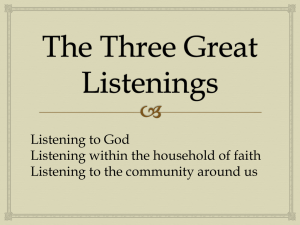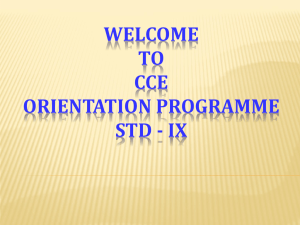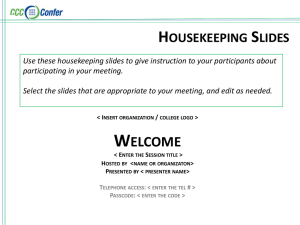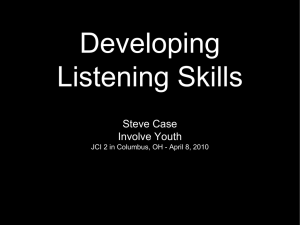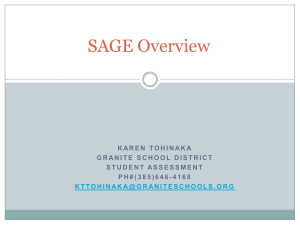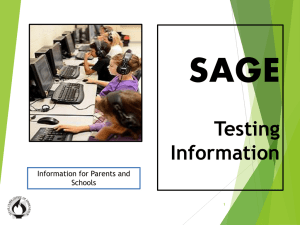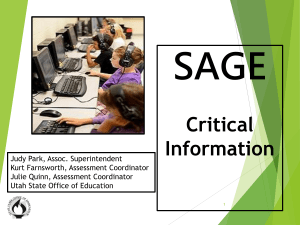PowerPoint Day 3 - Utah Education Network
advertisement
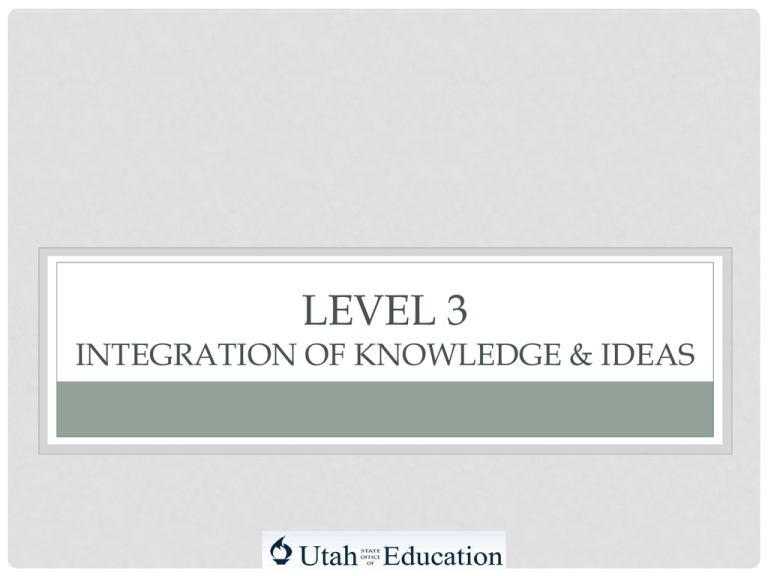
LEVEL 3 INTEGRATION OF KNOWLEDGE & IDEAS APPOINTMENT CLOCK • 1. Find someone you haven’t met yet. Have them sign your 3:00 appointment time – you sign theirs. • 2. Find someone else you aren’t terribly familiar with. Have them sign your 6:00 appointment time – you sign theirs. • 3. Find someone else who you don’t know well. Have them sign your 9:00 appointment time – you sign theirs. • 4. Find someone who looks nice, who hasn’t already signed your clock. Have them sign your 12:00 appointment time – you sign theirs. LITERATURE LEVEL 3 INTEGRATION OF KNOWLEDGE & IDEAS WHERE IS THIS IN THE UTAH CORE? Page 13 - RL2.7-9 Page 14 - RL3.7-9 LEVEL 3 QUESTIONING TOP HAT GRAPHIC ORGANIZER The Other Side Each Kindness The author Jacqueline Woodson teaches me about being a good citizen through her literature. One way to be a good citizen is to not judge others and be a good friend. Topic Sentence: WRITING LEVEL 3 QUESTIONS Inference question examples: How does each argument contribute to the whole piece? How does each idea contribute to the development of the piece? How does the sequence of events/order of claims develop the piece? Opinions, Arguments, and Inter-Textual Connections question examples: What do we know about the narrator? Who’s story is not represented? Compare and Contrast plot, theme, or setting question examples: How is theme of the two stories the same or different? How is the setting similar to the other story we have read? INFORMATIONAL TEXT LEVEL 3 INTEGRATION OF KNOWLEDGE & IDEAS WHERE IS THIS IN THE UTAH CORE? Page 15 - RI2.7 and RI2.9 Page 16 - RI3.7 and RI3.9 INFORMATIONAL TEXT LEVEL 3 ARTS CONNECTION WHERE IS THIS IN THE UTAH CORE? Page 13 - RL2.4 – beats, rhythm, rhymes; Page 15 - RI2.4 – meaning of words 2nd grade Science Page14 - RL3.4 meaning of words; Page 16 - RI3.4 meaning of words 3rd grade Science WHAT CAN BE LEARNED FROM RESEARCH ON MUSIC AND LEARNING • Students need to experience and understand the developmentally appropriate building blocks of mathematics to insure academic success later on (NAEYC, 2007). • Both music and mathematics have many connections, especially in patterning. • Brain research indicates that music instruction prepares the brain for mathematics and reading instruction. WHAT WE LEARNED CONTINUED • Skill-building music instruction helps mathematical and reading ability. • The brain benefits from music in ways that help mathematical and language arts understanding. • Countries where music is an equal required part of curriculum have top ranking mathematics scores (Jenson, 2000). WHAT WE LEARNED CONTINUED • It is estimated that as many as 30 million students do not have an education that involves music. • As budgets shrink music and arts programs are first to be cut (DiMaio, 2006). MUSIC CONNECTIONS • 4/4 Meter • (4 beats repeated over and over) • Beat (steady like a heart beat) • Rhythm (usually fits with the words) Try each one out with body percussion as you: 1. Clap, snap, pat legs twice 2. Combine all three 3. Add instruments ARTS CONNECTION POEM WITH INSTRUMENTS • Crescent Quarter Gibbous Full • Looking at the moon is never dull • Martha Avant, BTS Specialist, Davis District Sung to the tune of: Oh My Darling Clementine Oh the moon, we see it shining, Like a sphere, it is so bright, Cause the moon it is reflecting Suns own beaming, streaming light Moon’s appearance, it is lovely While it hangs in our night sky, And the moon it is rotating On its axis as it flies That old moon it likes to travel Round our Earth so constantly One full path around our Earth Is called an orbit you will see Oh the moon, it is much smaller ¾ smaller than our Earth, And with craters its been covered Since its airless, windless birth - repeat first stanza. Leslie Bertram 2c 2013 MOONLIGHT SONATA & CRAYON RESIST ART • Materials: “Moonlight Sonata” by Beethoven, • Art paper, Crayons, Paint Brushes, and water colored blue by water colors. • While the music plays and recalling what they have read, students will Draw or trace a circle coloring with crayons ½ that resembles the Earth and ½ that resembles the Moon. They may include other planets, stars etc. • After they have colored their picture heavily and completely, they will take some blue colored water and wash the entire picture with it. • They will attach their completed Diamonte Poem to the painting INCORPORATING SPEAKING & LISTENING • SL3.5- Create engaging audio recordings of stories or poems that demonstrate fluid reading at an understandable pace, add visual displays when appropriate to emphasize or enhance certain facts or details. • See Poems • Instructions for Educreations provided ASSESSMENT ASSESSMENT • New testing system - SAGE • Student Assessments for Growth and Excellence • Provided by AIR • American Institutes for Research • Standards Based • Authentic • Adaptive • Instant Reporting (after 2014) • Link to formative helps ASSESSMENT TYPES • SAGE FORMATIVE Tools • Formative assessments • Other Formative Learning Tools/Lesson Plans/Activities • Guides instruction • SAGE INTERIM ASSESSMENT • • • • Used to measure growth and progress Same bank of items as summative Predictive of summative Beginning and Middle of the Year (optional) • SAGE SUMMATIVE ASSESSMENT • End of year final assessment • School reporting measure • Training Test will be provided ASSESSMENT TIMELINE • SAGE Formative Fall 2013 • Teachers may start using this to guide their instruction • Teachers can start creating their own tests and adding their own items Spring 2014 • SAGE Summative Spring 2014 • No instant scoring available yet until cut scores are determined • ALL Assessments FALL 2014 QUESTION TYPES When students get to think about how to solve or respond the depth of knowledge increases • Natural Response • Students type in a written response • Equation Response • Response is an expression, equation, inequality, or number • Hot Text • Active text. Portions of text can be highlighted or dragged to one or more response boxes • Graphical Response • Student drags objects, selects regions, or constructs with tools in a graphical space • Simulation • Interactive- Students acts and item responds. Implemented as item or stimuli. NATURAL LANGUAGE RESPONSE SAMPLE QUESTION EQUATION RESPONSE SAMPLE QUESTION HOT TEXT SAMPLE QUESTION 40 GRAPHICAL RESPONSE SAMPLE QUESTION SAMPLE QUESTIONS • http://demo.tds.airast.org/airassessment • Must have Firefox Browser to Access SPEAKING AND LISTENING WHERE IS THIS IN THE UTAH CORE? Page 24 – Anchor Standards for Speaking and Listening SPEAKING AND LISTENING When I speak I share what I know in my head When I listen I add to my knowledge from what others have said SPEAKING AND LISTENING The step that connects reading to writing is speaking and listening Writing Speaking & Listening Reading SPEAKING AND LISTENING Speaking and listening are incorporated through cooperative learning strategies. BENEFITS OF COOPERATIVE LEARNING • The benefits of cooperative learning are plentiful. One obvious benefit, of course, is that the kids themselves get to do the talking INSTEAD of the teacher. • Promotes student learning and academic achievement • Increases students' retention of material learned • Enhances students' satisfaction with their learning experience • Helps students develop skills in oral communication • Promotes self-esteem COOPERATIVE LEARNING STRATEGIES • Read through the cooperative learning strategies • Meet with your scheduled appointments • 3:00 Appointment Share the cooperative learning strategies you currently use in your classroom and what makes them successful • 6:00 Appointment Share at least one strategy you would like to incorporate this next year and how you think it will benefit your students • 9:00 Appointment Discuss how you would explain the benefits of speaking and listening to a parent. QUICK WRITE RULES • You must write the whole time. • If you can not think of anything to write, write, “I’m thinking, I’m thinking, etc.” ASSIGNED TOPIC How will the information gleaned from the two articles and your experiences over the last three days effect student learning in your classroom? Cite evidence and examples. HOMEWORK • Write at least two Level 3 questions for Each Kindness. • Bring Unit 1 of your basal and/or a story you like to share with your students at the beginning of the school year.

